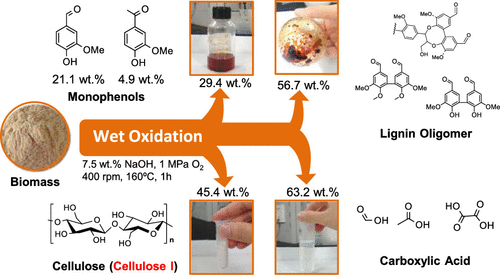当前位置:
X-MOL 学术
›
ACS Sustain. Chem. Eng.
›
论文详情
Our official English website, www.x-mol.net, welcomes your
feedback! (Note: you will need to create a separate account there.)
Complementing Vanillin and Cellulose Production by Oxidation of Lignocellulose with Stirring Control
ACS Sustainable Chemistry & Engineering ( IF 7.1 ) Pub Date : 2020-02-03 , DOI: 10.1021/acssuschemeng.9b04837 Yuting Zhu 1, 2 , Yuhe Liao 3 , Wei Lv 1 , Jing Liu 1, 2 , Xiangbo Song 1, 2 , Lungang Chen 1 , Chenguang Wang 1 , Bert F. Sels 3, 4 , Longlong Ma 1
ACS Sustainable Chemistry & Engineering ( IF 7.1 ) Pub Date : 2020-02-03 , DOI: 10.1021/acssuschemeng.9b04837 Yuting Zhu 1, 2 , Yuhe Liao 3 , Wei Lv 1 , Jing Liu 1, 2 , Xiangbo Song 1, 2 , Lungang Chen 1 , Chenguang Wang 1 , Bert F. Sels 3, 4 , Longlong Ma 1
Affiliation

|
Lignin transformation to high-value chemicals is key for forthcoming biorefineries. Here, we report efficient delignification of pine wood by oxidative biorefining in aqueous alkali, producing both vanillin and cellulose as valuable end products. Under optimal conditions, viz., 400 rpm, 160 °C, 1 h, 7.5 wt % NaOH, and 1 MPa O2, more than 90% of lignin is converted and fractionated into monophenolics (29 wt % on Kraft lignin basis and vanillin yield is 21.1 wt %) and small oligophenolics (56.7 wt %, average Mw between 300 and 600 Da), next to a pool of small carboxylic acids. Depending on the conditions, a substantial amount of white residue can be formed as a coproduct, comprising 45% yield of 95.5% pure fibrous crystalline cellulose I, or a less pure cellulose residue can be obtained, which is highly reactive toward levulinic and formic acid formation using acid catalysis. Liquor refining by liquid–liquid extraction facilitates thorough identification of the main products by gas chromatography–mass spectrometry (MS), heteronuclear single quantum coherence NMR, electrospray ionization quadrupole time-of-flight mass spectrometry, and gel permeation chromatography. The mass balance shows close to 70% carbon efficiency of biomass conversion into useful products. Surprisingly, agitation speed, in addition to base concentration, temperature, and reaction time, is a crucial parameter to overcome deeper oxidation/condensation of soluble lignin fragments and to avoid substantial cellulose degradation. Similar reactions with other feedstock such as eucalyptus (hardwood), grasses, and a bagasse waste stream demonstrate the feasibility of the reported oxidative catalytic fractionation and the strong dependency of the product distribution on biomass variability within the different fractions.
中文翻译:

通过搅拌控制氧化木质纤维素补充香草醛和纤维素生产
木质素向高价值化学品的转化是即将到来的生物精炼厂的关键。在这里,我们报告了通过在碱水溶液中进行氧化生物精炼来有效地对松木进行脱木素作用,从而产生了香草醛和纤维素,它们都是有价值的最终产品。在最佳条件下,即400 rpm,160°C,1 h,7.5 wt%的NaOH和1 MPa O 2,超过90%的木质素被转化并分馏为单酚类(以硫酸盐木质素为基准为29 wt%和香草醛收率为21.1 wt%)和低聚酚类化合物(56.7 wt%,平均M w介于300到600 Da之间),旁边是一小群羧酸。取决于条件,可以形成大量的白色残留物作为副产物,包括产率为45%的95.5%的纯纤维状结晶纤维素I,或者可以得到纯度较低的纤维素残留物,其对乙酰丙酸和甲酸的反应性高用酸催化生成。通过液-液萃取精制白酒有助于通过气相色谱-质谱(MS),异核单量子相干NMR,电喷雾电离四极杆飞行时间质谱和凝胶渗透色谱法对主要产品进行全面鉴定。质量平衡显示,生物质转化为有用产品的碳效率接近70%。出乎意料的是,搅拌速度,除了碱浓度,温度,反应时间和反应时间是克服可溶性木质素片段更深层氧化/缩合并避免纤维素大量降解的关键参数。与其他原料(如桉树(硬木),草和甘蔗渣废水)的类似反应证明了所报道的氧化催化分馏的可行性以及产物在不同馏分中对生物量变异性的强烈依赖性。
更新日期:2020-02-04
中文翻译:

通过搅拌控制氧化木质纤维素补充香草醛和纤维素生产
木质素向高价值化学品的转化是即将到来的生物精炼厂的关键。在这里,我们报告了通过在碱水溶液中进行氧化生物精炼来有效地对松木进行脱木素作用,从而产生了香草醛和纤维素,它们都是有价值的最终产品。在最佳条件下,即400 rpm,160°C,1 h,7.5 wt%的NaOH和1 MPa O 2,超过90%的木质素被转化并分馏为单酚类(以硫酸盐木质素为基准为29 wt%和香草醛收率为21.1 wt%)和低聚酚类化合物(56.7 wt%,平均M w介于300到600 Da之间),旁边是一小群羧酸。取决于条件,可以形成大量的白色残留物作为副产物,包括产率为45%的95.5%的纯纤维状结晶纤维素I,或者可以得到纯度较低的纤维素残留物,其对乙酰丙酸和甲酸的反应性高用酸催化生成。通过液-液萃取精制白酒有助于通过气相色谱-质谱(MS),异核单量子相干NMR,电喷雾电离四极杆飞行时间质谱和凝胶渗透色谱法对主要产品进行全面鉴定。质量平衡显示,生物质转化为有用产品的碳效率接近70%。出乎意料的是,搅拌速度,除了碱浓度,温度,反应时间和反应时间是克服可溶性木质素片段更深层氧化/缩合并避免纤维素大量降解的关键参数。与其他原料(如桉树(硬木),草和甘蔗渣废水)的类似反应证明了所报道的氧化催化分馏的可行性以及产物在不同馏分中对生物量变异性的强烈依赖性。











































 京公网安备 11010802027423号
京公网安备 11010802027423号